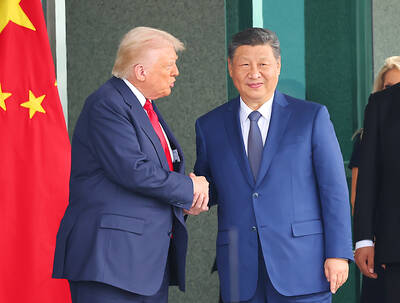Taiwan had a surplus of US$11.82 billion in its balance of payments in the second quarter, widening a surplus of US$4.59 billion a year earlier, the central bank’s latest tallies released yesterday showed.
The second-quarter surplus contrasted with a US$12.89 billion surplus posted in the first quarter, the central bank said.
The balance of payments is used to measure a nation’s payment flow of goods, services and investment across borders.
In the second quarter, the current-account surplus rose 40.8 percent to US$9.92 billion from US$7.04 billion a year earlier on a deeper decline in imports than that in exports amid the global slump, the central bank said.
The surplus narrowed from a US$12.89 billion surplus in the first quarter, the bank said.
Exports contracted 31.9 percent between April and June, while imports plunged 37.2 percent, Dawn Chen (陳一端), deputy chief of the central bank’s economic research department, told a media briefing.
As for the financial account, the direct and portfolio investment posted a net outflow of US$800 million and US$1.1 billion respectively in the second quarter, which Chen attributed to a rising purchase of foreign mutual funds and bonds by local residents and insurance firms.
The surplus on the income account, which includes dividend payments, widened to US$2.49 billion from US$1.64 billion a year earlier because of less income from direct investment and bank interest amid worldwide interest rate cuts.

RUN IT BACK: A succesful first project working with hyperscalers to design chips encouraged MediaTek to start a second project, aiming to hit stride in 2028 MediaTek Inc (聯發科), the world’s biggest smartphone chip supplier, yesterday said it is engaging a second hyperscaler to help design artificial intelligence (AI) accelerators used in data centers following a similar project expected to generate revenue streams soon. The first AI accelerator project is to bring in US$1 billion revenue next year and several billion US dollars more in 2027, MediaTek chief executive officer Rick Tsai (蔡力行) told a virtual investor conference yesterday. The second AI accelerator project is expected to contribute to revenue beginning in 2028, Tsai said. MediaTek yesterday raised its revenue forecast for the global AI accelerator used

TEMPORARY TRUCE: China has made concessions to ease rare earth trade controls, among others, while Washington holds fire on a 100% tariff on all Chinese goods China is effectively suspending implementation of additional export controls on rare earth metals and terminating investigations targeting US companies in the semiconductor supply chain, the White House announced. The White House on Saturday issued a fact sheet outlining some details of the trade pact agreed to earlier in the week by US President Donald Trump and Chinese President Xi Jinping (習近平) that aimed to ease tensions between the world’s two largest economies. Under the deal, China is to issue general licenses valid for exports of rare earths, gallium, germanium, antimony and graphite “for the benefit of US end users and their suppliers

Dutch chipmaker Nexperia BV’s China unit yesterday said that it had established sufficient inventories of finished goods and works-in-progress, and that its supply chain remained secure and stable after its parent halted wafer supplies. The Dutch company suspended supplies of wafers to its Chinese assembly plant a week ago, calling it “a direct consequence of the local management’s recent failure to comply with the agreed contractual payment terms,” Reuters reported on Friday last week. Its China unit called Nexperia’s suspension “unilateral” and “extremely irresponsible,” adding that the Dutch parent’s claim about contractual payment was “misleading and highly deceptive,” according to a statement

Artificial intelligence (AI) giant Nvidia Corp’s most advanced chips would be reserved for US companies and kept out of China and other countries, US President Donald Trump said. During an interview that aired on Sunday on CBS’ 60 Minutes program and in comments to reporters aboard Air Force One, Trump said only US customers should have access to the top-end Blackwell chips offered by Nvidia, the world’s most valuable company by market capitalization. “The most advanced, we will not let anybody have them other than the United States,” he told CBS, echoing remarks made earlier to reporters as he returned to Washington